REU Past Students
2023 2022 2021 2019 2018 2017 2016 2015 2014 2013 2012 2011
2016
-
Louis Apraku-Boadi - Chemistry, University of West Georgia
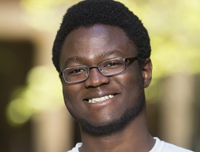 LinkedIn
LinkedIn
Educational Institution: University of West Georgia
List of Mentors: Dr. Janet Macdonald & Evan Robinson
Program: NSF REU
Research Project: Cu2S Nanocrystals as Signal Amplifiers for Biomolecule Detection
Poster: NSF REU Louis Apraku-Boadi Poster.pdf
Research Abstract: The research concerning nanomaterials is a growing and interesting field of study. They have applications in targeted drug delivery, photovoltaics, and, as is the case in this study, diagnostics. A recently developed method in our lab allows the production of highly stable crystal-bound Cu2S nanocrystals. Unlike the more ubiquitous surface-bound ligands, crystal-bound ligands are integrated in high coordination number sites – greatly enhancing Cu2S nanocrystal stability. Cu2S crystals, though small, contain thousands of individual Cu atoms. Using various chromogenic copper chelators, this fact can be exploited and used in biochemical and biological assays. One such chelator is cuprizone, which forms a chromogenic bidentate complex with Cu that has an intense and characteristic absorption band. This provides an effective means of detecting Cu at M concentrations. Here we assess the stability of crystal-bound nanoparticles and the viability of the copper-cuprizone complex as a reporter. -
Clayton Blythe - Physics/Economics, Central College of Iowa
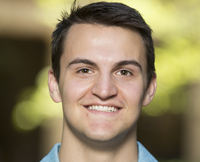 LinkedIn
LinkedIn
Educational Institution: Central College of Iowa
List of Mentors: Dr. Kalman Varga & Jorge Salas
Program: NSF REU
Research Project: Simulation of High Harmonic Generation in Helium due to Bichromatic Counterrotating Circularly Polarized Laser Fields
Poster: NSF REU Clayton Blythe Poster.pdf
Research Abstract: Attoscience is an important emerging area of research in modern atomic and molecular physics. In many electron-atom systems that are excited by femtosecond lasers, the recombination of an electron from the continuum occurs on the order of attoseconds. Precision on the sub-femtosecond and sub-angstrom scale will be necessary to probe the intricacies of light-matter interactions. High Harmonic Generation (HHG) is a technique that is growing in popularity for exploring these interactions. Harmonics with much higher frequencies and energies can be produced with various ellipticities. In this work, we present 3D Time Dependent Schroedinger Equation (TDSE) simulations combined with Time Dependent Density Functional Theory (TDDFT) for HHG in Helium. In this specific application, bichromatic counterrotating circularly polarized laser fields are employed, experimenting with various intensities, wavelengths, and pulse shapes. A circularly polarized fundamental is combined with its counterrotating second harmonic. The time-dependent electric field describes a Lissajous figure with threefold spatio-temporal symmetry resembling a clover. Dipole moment, ionization, and sensitivity to rotational symmetries are calculated, as well Fourier transformations employed to examine the intensity and ellipticity of emitted harmonics. Harmonics such as these with attosecond pulse lengths have potential applications in molecular and atomic chemistry such as photo-electron circular dichroism and x-ray magnetic circular dichroism. -
Adam Boyer - Chemistry, Emporia State University
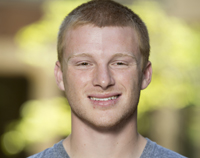 LinkedIn
LinkedIn
Educational Institution: Emporia State University
List of Mentors: Dr. David Cliffel & Evan Gizzie
Program: NSF REU
Research Project: Controlling the Orientation of Photosynthetic Protein Assembly on Solid Surfaces: a Strategy for Improving Bio-derived Solar Cells
Poster: NSF REU Adam Boyer Poster.pdf
Research Abstract: Current methods of harnessing energy have led to severe environmental impacts and necessitated the development of more conscientious methods, specifically solar cell conversion. Solar cell technology has attained efficiencies nearing 20% and is limited by high costs for processing silicon. One solution to this growing problem is implementing bio-derived solar cells with the photosynthetic protein, Photosystem I (PSI). Bio-derived solar cells provide remarkably clean energy production and utilizing Photosystem I affords a substantial supply of low cost material. Photosystem I acts as a pseudo-photodiode efficiently exciting electrons, and shuttling them unidirectionally through the protein; thus creating charge separation. However, harvesting the protein for solar cells leads to a mixed protein orientation on the solar cell surface. In order to maximize current flow, it is imperative that the orientation of PSI on a surface is controlled uniformly. In this work, Photosystem I was selectively modified with 2-iminothiolane during the extraction from spinach leaves while still thylakoid membrane bound. Following purification, modified PSI was allowed to self-assemble onto gold surfaces via high-affinity gold-thiol interactions. Once self-assembled onto the gold surface, photoelectrochemical analyses and highly resolved topography mapping techniques (i.e. Scanning Tunneling Microscopy) were utilized to investigate the photocurrent production under illumination and orientation of Photosystem I on the gold surface. Future applications of this exciting research includes considerable advances in bio-sensors and bio-technologies. -
Timera Brown - Biology, Tougaloo College
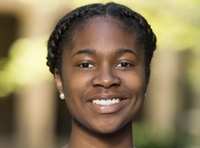 LinkedIn
LinkedIn
Educational Institution: Tougaloo College
List of Mentors: Dr. Eva Harth & Dian Beezer
Program: NSF REU
Research Project: Regenerative Medicine: Synthesis of Functionalized Polyglycidol Building Blocks for Diverse Network
Poster: NSF REU Timera Brown Poster.pdf
Research Abstract: Currently, a main focus of regenerative medicine is limited to embryonic stem cells as well as in vitro cell maturation. However, a more diverse approach using network forming materials is emerging as an innovative concept. Regenerative medicine is an interdisciplinary field of biomechanics which is geared toward the bioengineering and implementation of human cells, tissue, and/or organs in order to restore expected function. For example, currently in many knee operations where cartilage must be replaced, cartilage must be extracted and manipulated from cadavers or either grown from chondrocytes before being inserted into the patient. However, as an alternative to the delicate and time-consuming process of cartilage extraction and growth, this cartilage can be engineered through via polymeric networks. My project centers on acrylate-polyglycidol functionalization which due to the compound’s reactivity could combine with other materials and networks to lead to a robust polymer network with tunable crosslinking. This tunable amount of crosslinking could lead to the engineering of scaffolds of multiple sizes that could mimic not only cartilage tissue but potential other tissues such as dermal, bladder and liver tissues.- Conference Presentations
-T. Brown, D.B. Beezer, and E.M. Harth “Regenerative Medicine: Synthesis of Functionalized Polyglycidol Building Blocks for Diverse Networks” Kincheloe Society Symposium, Tougaloo, MS, October, 2016.
-T. Brown, D.B. Beezer, and E.M. Harth “Regenerative Medicine: Synthesis of Functionalized Polyglycidol Building Blocks for Diverse Networks” Annual Biomedical Research Conference for Minority Students, Tampa, FL, November, 2016.
- Conference Presentations
-
Kaleigh Ellis - Chemistry, Saint Mary's College
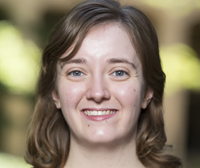 LinkedIn
LinkedIn
Educational Institution: Saint Mary's College
List of Mentors: Dr. Sandra Rosenthal & Kemar Reid
Program: NSF REU
Research Project: Engineering CdSSe-CdS Core/Shell Quantum Dots for Use in Single-Protein Imaging
Poster: NSF REU Kaleigh Ellis Poster.pdf
Research Abstract: Semiconductor nanocrystals, or quantum dots (QDs), play an important role in in vivo single-protein imaging due to their size-tunable optical properties. However, the synthesis of QDs that are ideal for biological imaging - namely that they have a narrow size distribution, retain high quantum yields (QYs), and are photostable - is difficult due to interior and surface-related defects, including the interaction of the electron-hole pair with the QD’s environment. By growing an inorganic shell onto the QD to passivate the QD the QY and photostability can be increased. The goal of this research is to optimize the QY and stability of alloyed CdSSe QDs by growing a CdS shell onto the alloyed cores and to study their photoluminescence and structural properties using fluorimetry and transmission electron microscopy (TEM), respectively. Two shell growth methods are explored: one using successive ion layer adsorption and reaction (SILAR) techniques with cadmium(II)-oleate and sulfur precursors to grow successive monolayers of CdS shell, and a second continuous infusion method in which Cd(II)-oleate and octanethiol are infused slowly over the course of the shell-growth process. Initial results indicate that the continuous infusion method is the preferred procedure, producing higher quantum yields and a narrow size distribution while also requiring less reaction time than the SILAR method. These brighter and more size-uniform CdS-shelled QDs have the potential to revolutionize the use of QDs in in vivo single-protein imaging.- Conference Presentations
-K. Ellis, K.R. Reid, and S.J. Rosenthal “Engineering CdSSe/CdS Core/Shell Quantum Dots for Use in Single-Protein Imaging” 10th Year Undergraduate Engineering Research Symposium, Notre Dame, IN, September, 2016.
-K. Ellis, K.R. Reid, and S.J. Rosenthal “Engineering CdSSe/CdS Core/Shell Quantum Dots for Use in Single-Protein Imaging” Women Chemist’s Symposium Senior Comprehensive Presentation, Notre Dame, IN, March, 2017. - Kaleigh was awarded Best Use of Graphics at the capstone poster session.
- Conference Presentations
-
Yasmin Graham - Mechanical Engineering, University of Maryland, Baltimore County
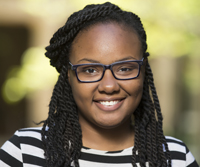 LinkedIn
LinkedIn
Educational Institution: University of Maryland, Baltimore County
List of Mentors: Dr. Sharon Weiss & Yiliang Zhou
Program: NSF REU
Research Project: Low Cost Portable Biosensors Made From Porous Silicon Annular Bragg Resonators
Poster: NSF REU Yasmin Graham Poster.pdf
Research Abstract: Point of care testing is a form of medical diagnostic testing which takes place at a patient’s bedside or directly at an active site. Our research is aimed at creating low cost, low power, high quality, portable biosensors that enable color-based detection and can be easily integrated with mobile devices such as a smartphones. The biosensing platform explored in this work is an annular Bragg resonator (ABR) on a porous silicon (PSi) substrate. ABRs are radially symmetric structures that possess a discrete refractive index profile that creates a cavity region surrounded by highly reflecting mirrors. These structures have been traditionally used to resonantly enhance the emission of fluorescent molecules incorporated in the cavity region. PSi, a nanostructured material formed by electrochemical etching of a silicon substrate, possesses a large surface area which is highly advantageous for capturing large quantities of molecular species inside the pores. To form a colorimetric biosensor, colloidal AgInS2/ZnS quantum dots (QDs) are infiltrated into PSi ABRs; the ABR modifies the QD emission, leading to a structure with a relatively narrow and distinct fluorescence spectrum. Since the QDs only cover a portion of the internal pore surface area, the remainder of the pore surface is available to selectively capture desired target molecules when appropriately functionalized. Target molecule binding in the pores modifies the ABR resonance wavelength and consequently shifts the peak emission wavelength of the embedded QDs. Hence, molecular binding events lead to a biosensor color change. The QDs embedded in PSi ABRs were excited with a 532 nm laser and the fluorescence emission was collected with a Raman microscope equipped with a 100x objective lens. An 8-fold enhancement of the peak QD intensity was measured when the QDs were embedded in a PSi ABRs compared to a planar PSi film. A preliminary experiment to detect 5 µM of Catalase protein caused a 30nm average shift of the QD photoluminescence peak which indicates that this platform has the potential to achieve highly sensitive biosensing.- Co-author Journal Publication
Y. Zhao, G. A. Rodriguez, Y. M. Graham, T. Cao, G. Gaur, and S. M. Weiss, “Resonant photonic structure in porous silicon for biosensing,” Proc. of SPIE 10081, 100810D (2017). - Conference Presentation
Y.M. Graham, Y. Zhao, G. Gaur, and S.M. Weiss, “Low Cost Portable Biosensors Made From Porous Silicon Annular Bragg Resonators” REU Symposium 2016, Arlington, VA, October, 2016. - Yasmin was awarded a $1K travel grant at the capstone poster session.
- Co-author Journal Publication
-
Marne Helbing - Engineering, University of Tennessee, Martin
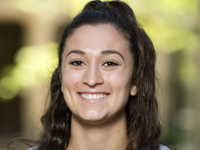 LinkedIn
LinkedIn
Educational Institution: University of Tennessee, Martin
List of Mentors: Dr. Florence Sanchez & Yonathan Reches
Program: NSF REU
Research Project: Reactivity of Nano-Particles in Cementitious Systems
Poster: NSF REU Marne Helbing Poster.pdf
Research Abstract: Nano-particles (NP’s) have been studied as additives for improving the mechanical and durability properties of cement-based materials. The contributions of NP’s to the cement system have been attributed to their high surface area to volume ratio, although the specific chemical interactions between NP’s and the cementitious system have yet to be defined. The intrinsic and catalytic reactivity of NP’s in cement-based systems were studied, including the effect of cement chemistry on the agglomeration of NP’s. NP’s were reacted with real and simulated cement systems, and their reaction products were characterized chemically and microstructurally. The effects of cement on the surface charge and agglomerate size of the NP’s were simulated using salt solutions and observed by dynamic light scattering (DLS). It was demonstrated that for the nano-TiO the nano-particles agglomerated to approximately 102 NP’s/agglomerate. Agglomeration further increased due to the effects of the ions in the salt solutions.- Co-author Journal Publication
Y. Reches, K. Thomson, M. Helbing, D.S. Kosson, and F. Sanchez “Agglomeration and reactivity of nanoparticles of SiO2, TiO2, Al2O3, Fe203, and clays in cement pastes and effects on compressive strength at ambient and elevated temperatures” Construction and Building Materials, 167, 860-873, (2018).
- Co-author Journal Publication
-
Eion Hindsman-Curry - Applied Physics/Mechanical Engineering, Morehouse College
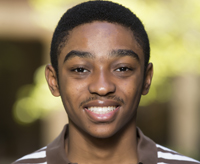 LinkedIn
LinkedIn
Educational Institution: Morehouse College
List of Mentors: Dr. Richard Haglund & Claire Marvinney
Program: NSF REU
Research Project: Enhanced Porosity and Exciton-Phonon Coupling in Zinc Oxide Nanopopcorn
Poster: NSF REU Eion Hindsman-Curry Poster.pdf
Research Abstract: Semiconductor zinc oxide (ZnO) nanostructures are acclaimed as efficient optoelectronic materials and stable light emitters at room temperature. Zinc oxide features a wide bandgap (3.37 eV) and a stable exciton (Ebinding=60 meV), and nanostructured ZnO used for various applications such as gas sensors, photocatalysts, nanolasers, etc. [1] A novel ZnO nanostructure, christened “nanopopcorn”, has been fabricated by a modified vapor solid method, evaporating Zn in a chamber at a temperature of 700°C to bond with O2 gas on a GaN substrate. The free-form crystalline structure has a high porosity, among other attributes, making it ideal for biological and molecular sensing. Zinc oxide nanopopcorn displays an enhanced surface area to volume ratio compared to planar and one-dimensional nanostructures and has multiple distinct exciton binding peaks. Using image analysis on select samples, a consistent surface area to volume ratio is observed of about 0.023:1 nm-1. This ratio is enhanced over that of ZnO nanowires, a commonly used nanostructure for optoelectronics and sensing applications. The higher surface area creates more bonding sites with the surrounding material, making ZnO nanopopcorn useful for optoelectronic enhancement techniques such as exciton-phonon and exciton-plasmon interactions. The exciton-phonon coupling and the exciton-plasmon coupling create novel vibrational and optical modes, respectively. Studying these fundamental properties will help us to fully characterize the physical and electronic properties of this novel material. Given these properties, ZnO nanopopcorn may be an ideal sensor for many medical and biological applications such as cancer cell detection [3] and electrochemical glucose sensing [4].1. Wang, X., Liu, W., Liu, J., Wang, .F, Kong, J., Qiu, S., He, C. and Luan, L. “Synthesis of Nestlike ZnO Hierarchically Porous Structures and Analysis of Their Gas Sensing Properties” Applied Materials and Interfaces, 4, 817-825 (2012).
2. Politi, J., Rea, I., Dardano, P., De Stefano, L. and Gioffre, M. “Versatile synthesis of ZnO nanowires for quantitative optical sensing of molecular biorecognition” Sensors and Actuators B: Chemical, 220, 705-711 (2015).
3. Sudhagar, S., Sathya, S., Pandian, K. and Lakshmi, B. “Targeting and sensing cancer cells with ZnO nanoprobes in vitro” 33, 1891-1896 (2011).
4. Ali, S. “Fabrication and characterization of ZnO nanostructures for sensing and photonic device applications” Linköping Studies in Science and Technology Dissertation No. 1412, (2011). -
Tao Hong - Engineering Science, CUNY Queensborough Community College
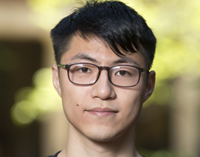 LinkedIn
LinkedIn
Educational Institution: CUNY Queensborough Community College
List of Mentors: Dr. Deyu Li & Lije Yang
Program: NSF REU
Research Project: A Microfluidic Device for Sorting C. elegans
Poster: NSF REU Tao Hong Poster.pdf
Research Abstract: Caenorhabditis (C.) elegans locomotion is a stereotyped behavior by generating waves of dorsal-ventral bends and propagating them forward along its body from head to tail. Noticeably absent from the C. elegans literature, however, are studies of evaluating the motility of nematode in waved-like channels in the microfluidic device. Major applications of immobilizing nematode are related to pressure involved process in the straight narrow-down channels. This presentation focus on studying of the spontaneity of mobility for C. elegans in wave-like channels. By utilizing this unique spontaneity, we designed and fabricated a microfluidic device which can sort and immobilize C.elegans from a colony mixed with nematodes in different larvae stage. The front part of channels in this microfluidic device is waved-like with the 30-micron diameter, so that only the fit-sized nematodes can swim in spontaneously and trapped in the body part which is straight and narrow down to 20 microns. Most medicine stimuli application of C.elegans is carried on synchronized well-fed young adults cultivated from only eggs with diameter vary from 30-35 micros. Synchronizing C.elegans by old method is labor-intensive and time-consuming. This design performs a convenience to separate nematodes within any region of diameter from an unsynchronized colony, thus enhance of the efficiency of immobilization and further biological stimuli of C. elegans.- Co-author Journal Publication
L. Yang, T. Hong, Y. Zhang, J.G. Sanchez Arriola, B.L. Nelms, R. Mu and D.Y. Li, “A microfluidic diode for sorting and immobilization of Caenorhabditis elegans” Biomedical Microdevices, 19, 38 (2017). - Tao was awarded a $1K travel grant at the capston poster session.
- Tao was awarded a 2017 Barry Goldwater Scholarship
- Tao received a Jack Kent Cooke UT Scholarship
- Tao was awarded a Bill Nye '77 Award
- Tao was awarded a NSF Graduate Research Fellowship in 2022.
- Tao was awarded a World-Class PD Soros Fellowshiop for New Americans in 2022.
- Co-author Journal Publication
-
Ayisha Jackson - Engineering, Brown University
 LinkedIn
LinkedIn
Educational Institution: Brown University
List of Mentors: Dr. Craig Duvall & Dr. Meredith Jackson & Thomas Werfel
Program: NSF REU
Research Project: The Use of Microfluidic Mixing Devices for Minimizing Polyplex Nanoparticle Size and Increasing Tumor Penetration
Poster: NSF REU Ayisha Jackson Poster.pdf
Research Abstract: Despite the use of various formulation methods for the polyplex packaging and delivery of siRNA, current polyplex formulations remain inconsistent with poor shelf life, and often particles that are too large to allow sufficient penetration of tumor tissue. To solve these formulation challenges, the Lee Visco-Jet Micro-mixer has been used to examine methods of improving siRNA polyplex formulation due to its ability to increase turbulence and particle interaction; varying flow-rate settings to determine optimal conditions. Dynamic light scattering (DLS) was used to quantify the micro-mixer’s effect on PEGylated micelles’ size and polydispersity; using multiple polymers with DMAEMA and BMA cores and varying coronas. To test particle stability, the hand-mixed and micro-mixed particles were compared after lyophilization and reconstitution. Furthermore, a Ribogreen assay was used to determine the encapsulation efficiencies of each particle formulation method.Overall, these tests have shown that the use of the micro-mixer consistently minimizes particle sizes from a hand-mixed average of around 100 nm to around 60 nm. The micro-mixer also significantly improves the encapsulation efficiency of siRNA during formulation from an average of 65% up to almost 80%. Further studies will include examining the effects of excipient additions for increased long-term stability of nanoparticles. Additionally, further studies will include in vitro testing of micro-mixed nanoparticle performance on tumor penetration using 3D matrigel-based models. These studies also show that the micro-mixed particles were more stable after freeze-drying and reconstitution than the hand-mixed counterparts. The above mentioned results indicate the ability of micro-mixer use to provide optimal complexing processes for clinical practice.- Co-author Journal Publication
M.A. Jackson, T.A. Werfel, E.J. Curvino, F. Yu, T.E. Kavanaugh, S.M. Sarett, M.D. Dockery, K.V. Kilchrist, A.N. Jackson, T.D. Giorgio, and C.L. Duvall “Zwitterionic Nanocarrier Surface Chemistry Improves siRNA Tumor Delivery and Silencing Activity Relative to Polyethylene Glycol” ACS Nano, 11 (6) 5680-5696 (2017). - Conference Presentation
A. Jackson, M.A. Jackson, T.A. Werfel, and C.L. Duvall “The Use of Microfluidic Mixing Devices for Minimizing Polyplex Nanoparticle Size and Increasing Tumor Penetration” Society for Biomaterials Annual Meeting and Exposition, Minneapolis, MN, April, 2017. - Ayisha was awarded a $1K travel grant at the capstone poster session.
- Co-author Journal Publication
-
Amira Kessem - Renewable Energy Engineering, Alfred University
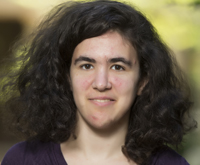 Educational Institution: Alfred University
Educational Institution: Alfred University
List of Mentors: Dr. David Cliffel & Dr. Kane Jennings & Dr. Jeremy Beam
Program: NSF REU
Research Project: Strategies for Scaling Up Solid State Photosystem I-based Devices for Solar Energy Conversion
Poster: NSF REU Amira Kessem Poster.pdf
Research Abstract: In order to commercialize solid state solar cell devices, it is important to show that they can be scaled up to industrially relevant sizes. Photosystem I (PSI)-based solid state devices for solar energy conversion have shown to yield an appreciable photocurrent over small surface areas. However, devices with larger surface areas have so far not been synthesized. This research project focuses on the fabrication and testing of solid state PSI-based solar cell devices of 4cm diameter and 6cm diameter. It includes two device architectures: p-Si/PSI/ZnO and TiO2/PSI-polyaniline. -
Anne Leonhard - Chemical Engineering/Computational Science, Rose-Hulman Institute of Technology
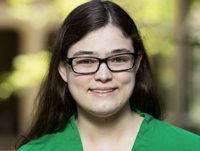 LinkedIn
LinkedIn
Educational Institution: Rose-Hulman Institute of Technology
List of Mentors: Dr. Clare McCabe & Tim Moore
Program: NSF REU
Research Project: Coarse-Grained Simulations of the Self-Assembly of Skin-Relevant Lipid Structures
Poster: NSF REU Anne Leonhard Poster.pdf
Research Abstract: The barrier properties of the skin are largely governed by the lipid lamellae of the outermost layer of skin, the stratum corneum (SC). While the composition of the SC is known, the molecular-level features of the lipid organization are not. This information would be useful for repairing an impaired skin barrier or selectively bypassing the barrier, e.g., for transdermal drug delivery. Molecular simulation allows precise control over system composition and direct visualization of the system structure, making it a useful tool for studying such systems. The slow kinetics of lamellar self-assembly make using atomistic models computationally inefficient. Thus, coarse-grained models, where groups of atoms are treated as individual interaction sites, are employed to study the self-assembly of SC lipids. Here, coarse-grained models of SC lipids, including CER NS C16, CER NS C24, cholesterol, and free fatty acids, are simulated to gain insight into the low-energy structures adopted by mixtures of these lipids. Self-assembly of both single and stacked bilayers in solution is studied by cooling systems from a high-temperature, disordered state. Structural properties, such as lipid positioning, angle between lipid tails, tilt angle of lipid tails, nematic order parameter, and bilayer lipid density are calculated. These properties are compared between simulations to determine the effects of lipid concentration on bilayer structure. This research increases understanding of the structural role of various lipids in SC organization and is an important step in the use of accurate coarse-grained models of the SC lipids.- Co-author Journal Publication
T. C. Moore, C. R. Iacovella, A. C. Leonhard, A. L. Bunge, and C. McCabe, “Molecular Dynamics Simulations of Stratum Corneum Lipid Mixtures: A Multiscale Perspective, Biochemical and Biophysical Research Communications, 498, 313-318 (2018). [Invited] - Conference Presentations
-A. Leonhard, T.C. Moore, C. McCabe “Coarse-Grained Simulations of the Self-Assembly of Skin-Relevant Lipid Structures” AICHE Student Conference, San Francisco, CA, November 2016.
-T. C. Moore, A. C. Leonhard, C. R. Iacovella, R. Hartkamp, A. L. Bunge, and C. McCabe, “Self-Assembly of Model Stratum Corneum Lipid Mixtures,” Gordon Research Conference on the Barrier Function of Mammalian Skin, Waterville Valley, NH, August, 2017.
-T. C. Moore, D. Xia, A. C. Leonhard, C. R. Iacovella, R. Hartkamp, A. L. Bunge, C. McCabe, “Self-Assembly Simulations of Stratum Corneum Lipid Mixtures,” AIChE Annual Meeting, Minneapolis, November, 2017. - Anne was awarded a NSF Graduate Research Fellowship
- Co-author Journal Publication
-
Clara Simons - Physics/German, Wofford College
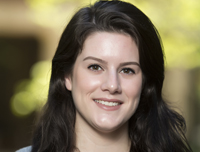 LinkedIn
LinkedIn
Educational Institution: Wofford College
List of Mentors: Dr. Kane Jennings & Max Robinson
Program: NSF REU
Research Project: Photocatalytic Photosystem I/PEDOT Composite Films Prepared by Vapor Phase Polymerization
Poster: NSF REU Clara Simons Poster.pdf
Research Abstract: Photosystem I (PSI) is a globally abundant protein complex that facilitates the light reactions of photosynthesis in green plants and cyanobacteria with near-unity quantum efficiency, and has been used in solid state cells and hydrogen production. Extracted PSI can also be rapidly assembled atop conductive surfaces for photocatalytic response. We report the incorporation of PSI proteins within an electrically conductive poly(3,4-ethylenedioxythiophene) matrix using a vapor phase approach, allowing for the desired increase of impedance and conductance in our films. The inclusion of Friedel-Crafts catalyst (FeCl3) within drop cast solutions of PSI permits subsequent polymerization when in contact with an appropriate monomer, while an ideal amount of surfactant (Triton X-100) improves film smoothness and uniformity. Using these techniques, we observe optimal photocurrents of nearly 1 μA/cm2 over control films when 6μM PSI is included in the drop cast solution. PSI’s absorbance spectrum has a characteristic peak at 675nm, which is indicative of its red light absorption and photocatalysis and which contributes significantly to photocurrent outputs following the vapor phase deposition of our polymer. Due to the significant red light photoresponse contribution of composite films, we suggest their use within light-activated counter electrodes in dye-sensitized solar cells.- Co-author Journal Publication
M.T. Robinson, C.E. Simons, D.E. Cliffel, and G.K. Jennings, “Photocatalytic photosystem I/PEDOT composite films prepared by vapor-phase polymerization” Nanoscale, 9 (18), 6158-6166 (2017). - Clara was awarded Best Layout at the the capstone poster session.
- Co-author Journal Publication
